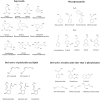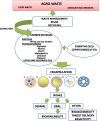Natural Macromolecules as Carriers for Essential Oils: From Extraction to Biomedical Application
- PMID: 32671026
- PMCID: PMC7330110
- DOI: 10.3389/fbioe.2020.00563
Natural Macromolecules as Carriers for Essential Oils: From Extraction to Biomedical Application
Abstract
Essential oils (EOs) and their main constituents, the terpenes, are widely studied, mostly relating to their antioxidant ability and bioactivity, such as antimicrobial, anticancer, anti-inflammatory, and range of other actions in the living systems. However, there is limited information on their bioavailability, especially upon clinical studies. Having in mind both strong biological effects and health benefits of EOs and their specific physicochemical properties (volatility, lipophilic character, low water solubility or insolubility, viscosity, expressed odor, concentration-dependent toxicity, etc.), there is a need for their encapsulation for target delivery. Encapsulation of EOs and their constituents is the prerequisite for enhancing their oxidative stability, thermostability, photostability, shelf life, and biological activity. We considered various carrier types such a (1) monophase and polyphase polysaccharide hydrogel carriers, (2) polysaccharide-protein carriers, and (3) lipid carriers in the context of physicochemical and engineering factors. Physicochemical factors are encapsulation efficiency, chemical stability under gastric conditions, mechanical stability, and thermal stability of carrier matrices. Choice of carrier material also determines the encapsulation technique. Consequently, the engineering factors are related to the advantage and disadvantage of various encapsulation techniques frequently used in the literature. In addition, it was intended to address the interactions between (1) main carrier components, such as polysaccharides, proteins, and lipids themselves (in order to form chemically and mechanically stable structure); (2) main carrier components with pepsin under gastric conditions (in order to form resistant material under gastric conditions); and (3) main carrier components with EOs (in order to enhance encapsulation efficiency), as a necessary precondition for whole process optimization. Finally, different sources for obtaining natural carrier macromolecules are surveyed, especially the agro-waste materials and agricultural and food by-products. This review article highlights the bioavailability aspects of encapsulated EOs and physicochemical and engineering factors concerning natural macromolecule carriers for their target delivery and application.
Keywords: bioavailability; capsulation; gastric digestion; isoprenoids; matrix material; reuse.
Copyright © 2020 Dajic Stevanovic, Sieniawska, Glowniak, Obradovic and Pajic-Lijakovic.
Figures





References
-
- Ahmad M., Ashraf B., Gani A., Gani A. (2018). Microencapsulation of saffron anthocyanins using β glucan and β cyclodextrin: microcapsule characterization, release behaviour and antioxidant potential during in-vitro digestion. Int. J. Biol. Macromol. 109, 435–442. 10.1016/j.ijbiomac.2017.11.122 - DOI - PubMed
-
- Anbinder P. S., Deladino L., Navarro A. S., Amalvy J. I., Martino M. N. (2011). Yerba mate extract encapsulation with alginate and chitosan systems: interactions between active compound encapsulation polymers. J. Encap. Adsorp. Sci. 1, 80–87. 10.4236/jeas.2011.14011 - DOI
Publication types
LinkOut - more resources
Full Text Sources
Other Literature Sources

